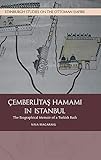Cemberlitas Hamami in Istanbul : Biographical Memoir of a Turkish Bath / Nina Macaraig.
Material type: TextSeries: Edinburgh Studies on the Ottoman Empire : ESOEPublisher: Edinburgh : Edinburgh University Press, [2022]Copyright date: ©2018Description: 1 online resource (392 p.) : 93 images and 4 tablesContent type:
TextSeries: Edinburgh Studies on the Ottoman Empire : ESOEPublisher: Edinburgh : Edinburgh University Press, [2022]Copyright date: ©2018Description: 1 online resource (392 p.) : 93 images and 4 tablesContent type: - 9781474434102
- 9781474434126
- 391.640949618
- online - DeGruyter
| Item type | Current library | Call number | URL | Status | Notes | Barcode | |
|---|---|---|---|---|---|---|---|
 eBook
eBook
|
Biblioteca "Angelicum" Pont. Univ. S.Tommaso d'Aquino Nuvola online | online - DeGruyter (Browse shelf(Opens below)) | Online access | Not for loan (Accesso limitato) | Accesso per gli utenti autorizzati / Access for authorized users | (dgr)9781474434126 |
Frontmatter -- Contents -- List of Tables -- List of Figures -- Preface -- Acknowledgements -- Note on Transliteration -- Introduction -- 1. Ancestry -- 2. Family -- 3. From Birth to Breadwinner -- 4. Impressions and Identity -- 5. In Sickness and in Health -- 6. Old Age -- 7. Second Spring -- Epilogue -- Appendix: Endowment Deed of the Atik Valide Vakfı (VGM, D. 1766) -- Notes -- References -- Index
restricted access online access with authorization star
http://purl.org/coar/access_right/c_16ec
Tells the life story of Istanbul’s Çemberlitaş Hamamı, providing a case study for the cultural, social and economic functions of Turkish bathhouses over timeWeaves together Ottoman and modern Turkish architectural, cultural, social, economic and other strands of history in examining an important element of everyday lifeApplies a biographical approach that presents a new paradigm for the discussion of architectural monuments, not only in an Ottoman context, but across time and spaceReconstructs the story of the hamam using architectural surveys, archival documents, media analysis and participant observationTakes an experimental approach in terms of the organisation and presentation of Ottoman architectural historyBathhouses (hamams) play a prominent role in Turkish culture, because of their architectural value and social function as places of hygiene, relaxation and interaction. Continuously shaped by social and historical change, the life story of Mimar Sinan’s Çemberlitaş Hamamı in Istanbul provides an important example: established in 1583/4, it was modernised during the Turkish Republic (since 1923) and is now a tourist attraction. As a social space shared by tourists and Turks, it is a critical site through which to investigate how global tourism affects local traditions and how places provide a nucleus of cultural belonging in a globalised world.This original study, taking a biographical approach to tell the story of a Turkish bathhouse, contributes to the fields of Islamic, Ottoman and modern Turkish cultural, architectural, social and economic history.
Mode of access: Internet via World Wide Web.
In English.
Description based on online resource; title from PDF title page (publisher's Web site, viewed 29. Jun 2022)


